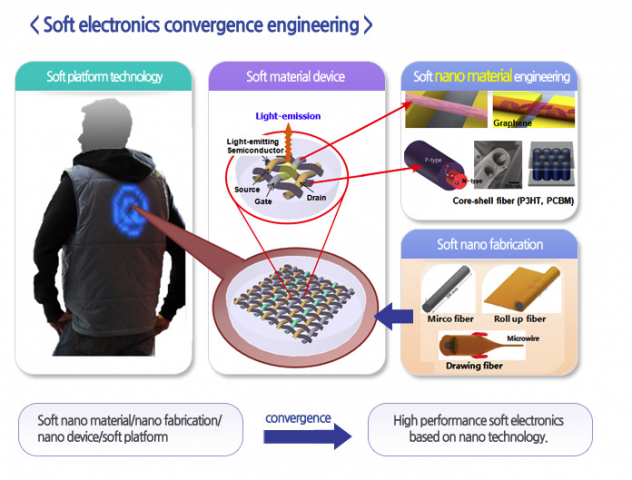The Apple Watch is now shipping with predictions it will bust all records for the nascent wearable category, with the lift coming primarily from the fan-boy base (OK, girls too) that believes Apple can do no wrong when it comes to adding cool stuff to my ever so plugged-in life.

 Korea’s Center for Advanced Soft Electronics technology development goals, Source: CASE
Korea’s Center for Advanced Soft Electronics technology development goals, Source: CASE
But the jury is still out on this first generation product from Apple that it will successfully “cross the chasm from early adopter to mainstream consumer device”. The Apple Watch delivers a bevy of sensors to the wrist, frees up both hands while empowering some level of digital engagement and serves as yet another “second screen” from which to engage the world. So what’s not to like?
Well an almost $400 (entry level) price tag for one, a me-too (hard and square) display that does nothing to excite the hoi polloi, unproved use models that include holding the wrist (elbow extended) in an uncomfortable position for prolonged periods of time just to play with this new toy, the list goes on. Add to that skeptics that include our own Ken Werner (see his excellent piece Smart Watches are Smart – but are they Sensible?) and there is room for the possibility that Apple just may strike out in the wearable space, much like Google did with its Project Glass initiative, pulling back and retrenching. But what is plan B?
Well, in the SID symposium, session 65 on an 18-inch flexible OLED display technology, LG research scientist Jonggeun Yoon (and team) showed a slide at the end of their presentation that revealed the company is in some level of collaboration with Korea’s Center for Advanced Soft Electronics initiative (CASE for short). The five year project is in year three now with a set of lofty goals that will no less than transform our very concept of wearable displays, moving them totally beyond “devices” to – well textile, clothing, even sensor laden patches we wear directly on the skin or lenses for the eye.
 Shows relative size of Smart-Watch market vis-a-vis other devices, from IHS Wearable Conference at SID 2015 Source: IHS
Shows relative size of Smart-Watch market vis-a-vis other devices, from IHS Wearable Conference at SID 2015 Source: IHS
To CASE, soft electronics convergence engineering consists of soft nano material / nano fabrication / nano device / soft platform, all converge to yield high performance soft electronics that are based on nano materials. A soft material device is described by the group as a textile based light emitting semiconductor that includes source, gate and drain literally woven into soft nano material. Soft nano fabrication is based on the micro fibers, roll up fiber and microwave drawing fiber. The result, a soft platform technology embedded into a form of clothing we wear
To get there, the group identified core technology projects that include concept soft materials (like identifying molecular based nano structures in both two- and multi-dimensional offerings.) Core technology 2 focuses on Soft nano fabrication and engineering and was the link between the CASE group and LG’s flex OLED initiative. Here the study includes flexibility maximization of electrodes and substrates, structure-derivative based nano pattern engineering plus surface and interface control of these nano materials. A second area of focus here includes high resolution soft material patterning.

Core technology three includes Soft nano device engineering that include producing high performance IC (integrated circuit) devices, human friendly sensors (think soft nano based contact lenses) and other soft quantum devices based on these new architectures.
Of course, time will tell if the next Apple Watch or some iteration will catch fire and move the mainstream forward in the pursuit of device nirvana. But just perhaps it is going to take a shift in our technology paradigm beyond “device thinking” for truly wearable displays to be meaningful to consumers; and it’s nice to know there is a plan B. – Steve Sechrist
